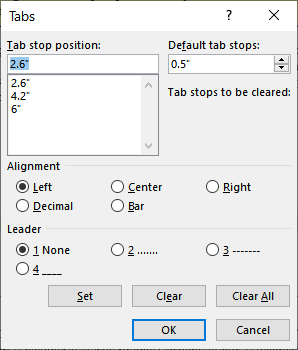Please Note: This article is written for users of the following Microsoft Word versions: 2007, 2010, 2013, 2016, 2019, 2021, and Word in Microsoft 365. If you are using an earlier version (Word 2003 or earlier), this tip may not work for you. For a version of this tip written specifically for earlier versions of Word, click here: Deleting All Tab Stops.
Written by Allen Wyatt (last updated July 2, 2022)
This tip applies to Word 2007, 2010, 2013, 2016, 2019, 2021, and Word in Microsoft 365
Joan is looking for the quickest way to delete all of the tab stops in a Word document. She wonders, specifically, if there is a keyboard shortcut that will do it.
There is no keyboard shortcut to remove tab stops—you must use the Tabs dialog box to accomplish the task. While you can use the keyboard to call up the Tabs dialog box and make selections within it, doing so doesn't technically count as a "keyboard shortcut." Here is the quickest way to delete all tab stops:

Figure 1. The Tabs dialog box.
Some have suggested that a quick way to delete tab stops is to simply select all the text (Ctrl+A) and then press Ctrl+Q. What this does is to remove all explicit paragraph formatting from the text. While it is true that the tab stops are a paragraph format, Ctrl+Q just removes any explicitly added tab stops; it sets the paragraphs back to whatever formatting is defined for each paragraph's style. So if the underlying paragraph style has tab stops defined, then those tab stops remain after Ctrl+Q is pressed—not all tab stops are removed.
If you need to remove the tab stops from a large number of documents, then you may want to use a macro to do the job. The following single-line macro removes all the tab stops from all paragraphs in the current document:
Sub TabsGone()
ActiveDocument.Paragraphs.TabStops.ClearAll
End Sub
You should understand two things about this discussion. First, deleting all tab stops doesn't get rid of any of the tab characters in the document. The best way to get rid of those is to use Word's Find and Replace capabilities.
Second, when you get rid of tab stops, Word's default tab stops automatically come into play. By design, the default tab stops are every half-inch, although you can change the default tab stop settings as described in other issues of WordTips. What you cannot do, however, is get rid of the default tab stops; there is no way to do this.
Note:
WordTips is your source for cost-effective Microsoft Word training. (Microsoft Word is the most popular word processing software in the world.) This tip (10191) applies to Microsoft Word 2007, 2010, 2013, 2016, 2019, 2021, and Word in Microsoft 365. You can find a version of this tip for the older menu interface of Word here: Deleting All Tab Stops.

The First and Last Word on Word! Bestselling For Dummies author Dan Gookin puts his usual fun and friendly candor back to work to show you how to navigate Word 2019. Spend more time working and less time trying to figure it all out! Check out Word 2019 For Dummies today!
Word offers a variety of tabs that define different ways to align text. If you need to align numeric values, you'll ...
Discover MoreIf you use a tab stop in your footer to align information at the right margin, you may not get what you expect when you ...
Discover MoreNeed to have some text at the left margin and some at the right, all on the same line? It's easy to do if you use your ...
Discover MoreFREE SERVICE: Get tips like this every week in WordTips, a free productivity newsletter. Enter your address and click "Subscribe."
2025-02-07 09:12:49
Barry
The above tip ends with:
... of WordTips. What you cannot do, however, is get rid of the default tab stops; there is no way to do this.
If the 'Default tab stops:' setting is set at zero it effectively 'removes' the default tabs!
I have no idea what if any potential promlems might be created by doing this.
Any insight will obviously be appreciated.
Got a version of Word that uses the ribbon interface (Word 2007 or later)? This site is for you! If you use an earlier version of Word, visit our WordTips site focusing on the menu interface.
Visit the WordTips channel on YouTube
FREE SERVICE: Get tips like this every week in WordTips, a free productivity newsletter. Enter your address and click "Subscribe."
Copyright © 2025 Sharon Parq Associates, Inc.
Comments